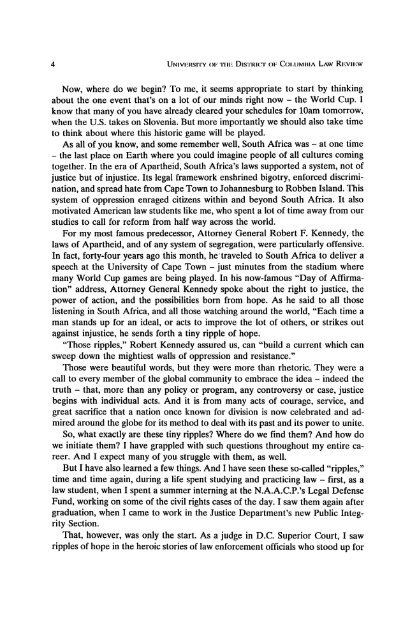Download Full Volume - UDC Law Review
Download Full Volume - UDC Law Review
Download Full Volume - UDC Law Review
- No tags were found...
You also want an ePaper? Increase the reach of your titles
YUMPU automatically turns print PDFs into web optimized ePapers that Google loves.
4 UNIVERSITY OF TilE DISTRICr OF COLUMBIA LAW REVIEWNow, where do we begin? To me, it seems appropriate to start by thinkingabout the one event that's on a lot of our minds right now - the World Cup. Iknow that many of you have already cleared your schedules for lOam tomorrow,when the U.S. takes on Slovenia. But more importantly we should also take timeto think about where this historic game will be played.As all of you know, and some remember well, South Africa was - at one time- the last place on Earth where you could imagine people of all cultures comingtogether. In the era of Apartheid, South Africa's laws supported a system, not ofjustice but of injustice. Its legal framework enshrined bigotry, enforced discrimination,and spread hate from Cape Town to Johannesburg to Robben Island. Thissystem of oppression enraged citizens within and beyond South Africa. It alsomotivated American law students like me, who spent a lot of time away from ourstudies to call for reform from half way across the world.For my most famous predecessor, Attorney General Robert F. Kennedy, thelaws of Apartheid, and of any system of segregation, were particularly offensive.In fact, forty-four years ago this month, he'traveled to South Africa to deliver aspeech at the University of Cape Town - just minutes from the stadium wheremany World Cup games are being played. In his now-famous "Day of Affirmation"address, Attorney General Kennedy spoke about the right to justice, thepower of action, and the possibilities born from hope. As he said to all thoselistening in South Africa, and all those watching around the world, "Each time aman stands up for an ideal, or acts to improve the lot of others, or strikes outagainst injustice, he sends forth a tiny ripple of hope."Those ripples," Robert Kennedy assured us, can "build a current which cansweep down the mightiest walls of oppression and resistance."Those were beautiful words, but they were more than rhetoric. They were acall to every member of the global community to embrace the idea - indeed thetruth - that, more than any policy or program, any controversy or case, justicebegins with individual acts. And it is from many acts of courage, service, andgreat sacrifice that a nation once known for division is now celebrated and admiredaround the globe for its method to deal with its past and its power to unite.So, what exactly are these tiny ripples? Where do we find them? And how dowe initiate them? I have grappled with such questions throughout my entire career.And I expect many of you struggle with them, as well.But I have also learned a few things. And I have seen these so-called "ripples,"time and time again, during a life spent studying and practicing law - first, as alaw student, when I spent a summer interning at the N.A.A.C.P.'s Legal DefenseFund, working on some of the civil rights cases of the day. I saw them again aftergraduation, when I came to work in the Justice Department's new Public IntegritySection.That, however, was only the start. As a judge in D.C. Superior Court, I sawripples of hope in the heroic stories of law enforcement officials who stood up for














